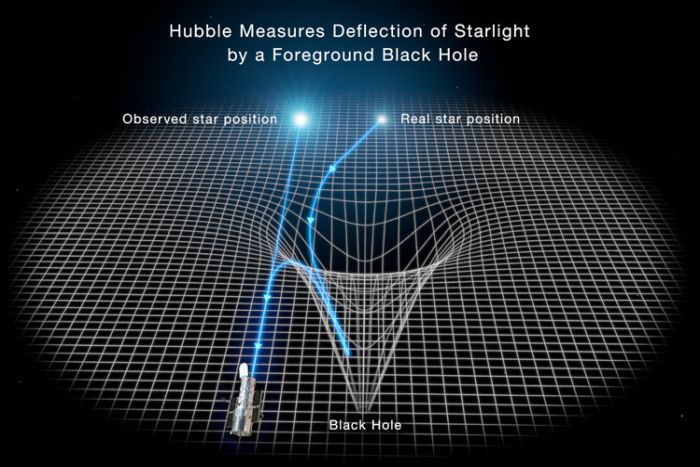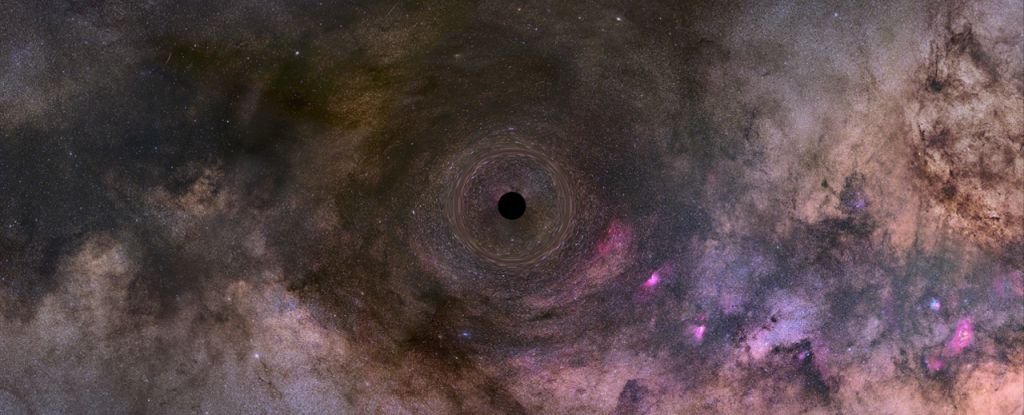Products You May Like
The first detection of what appears to be a rogue black hole drifting through the Milky Way, revealed earlier this year, just got important validation.
A second team of scientists, conducting a separate, independent analysis, has reached almost the same finding, adding weight to the idea that we’ve potentially identified a rogue black hole wandering the galaxy.
Led by astronomers Casey Lam and Jessica Lu of the University of California, Berkeley, the new work has arrived at a slightly different conclusion, however. Given the mass range of the object, it could be a neutron star, rather than a black hole, according to the new study.
Either way, though, this means that we may have a new tool for searching for ‘dark’, compact objects that are otherwise undetectable in our galaxy, by measuring the way their gravitational fields warp and distort the light of distant stars as they pass in front of them, called gravitational microlensing.
“This is the first free-floating black hole or neutron star discovered with gravitational microlensing,” Lu says.
“With microlensing, we’re able to probe these lonely, compact objects and weigh them. I think we have opened a new window onto these dark objects, which can’t be seen any other way.”
Black holes are theorized to be the collapsed cores of massive stars that have reached the ends of their lives and ejected their outer material. Such black hole precursor stars – bigger than 30 times the mass of the Sun – are thought to live relatively short lives.
According to our best estimates, therefore, there should be as many as 10 million to 1 billion stellar-mass black holes out there, drifting peacefully and quietly through the galaxy.
But black holes are called black holes for a reason. They emit no light that we can detect, unless material is falling onto them, a process that generates X-rays from the space around the black hole. So if a black hole is just hanging out, doing nothing, we have almost no way of detecting it.
Almost. What a black hole does have is an extreme gravitational field, so powerful that it warps any light that travels through it. For us, as observers, that means we might see a distant star appear brighter, and in a different position, than how it appears normally.
On 2 June 2011, that’s exactly what happened. Two separate microlensing surveys – the Optical Gravitational Lensing Experiment (OGLE) and Microlensing Observations in Astrophysics (MOA) – independently recorded an event that ended up peaking on July 20.
This event was named MOA-2011-BLG-191/OGLE-2011-BLG-0462 (shortened to OB110462), and because it was unusually long and unusually bright, scientists homed in for a closer look.
“How long the brightening event lasts is a hint of how massive the foreground lens bending the light of the background star is,” Lam explains.
“Long events are more likely due to black holes. It’s not a guarantee, though, because the duration of the brightening episode not only depends on how massive the foreground lens is, but also on how fast the foreground lens and background star are moving relative to each other.
“However, by also getting measurements of the apparent position of the background star, we can confirm whether the foreground lens really is a black hole.”
 Illustration showing how Hubble views a microlensing event. (NASA, ESA, STScI, Joseph Olmsted)
Illustration showing how Hubble views a microlensing event. (NASA, ESA, STScI, Joseph Olmsted)
In this case, observations of the region were taken on eight separate occasions using the Hubble Space Telescope, up until 2017.
From a deep analysis of this data, a team of astronomers led by Kailash Sahu of the Space Telescope Science Institute concluded that the culprit was a microlensing black hole clocking in at 7.1 times the mass of the Sun, at a distance of 5,153 light-years away.
Lu and Lam’s analysis now adds more data from Hubble, as recently captured as 2021. Their team found that the object is somewhat smaller, between 1.6 and 4.4 times the mass of the Sun.
This means that the object could be a neutron star. That’s also the collapsed core of a massive star, one that started out between 8 and 30 times the mass of the Sun.
The resulting object is supported by something called neutron degeneracy pressure, whereby neutrons don’t want to occupy the same space; this prevents it from completely collapsing into a black hole. Such an object has a mass limit of around 2.4 times the mass of the Sun.
Interestingly, no black holes have been detected below around 5 times the mass of the Sun. This is referred to as the lower mass gap. If the work of Lam and her colleagues is correct, that means we could have the detection of a lower mass gap object on our hands, which is very tantalizing.
The two teams came back with different masses for the lensing object because their analyses returned different results for the relative motions of the compact object and the lensed star.
Sahu and his team found that the compact object is moving at a relatively high velocity of 45 kilometers per second, as the result of a natal kick: a lopsided supernova explosion can send the collapsed core speeding away.
Lam and her colleagues got 30 kilometers per second, however. This result, they say, suggests that perhaps a supernova explosion is not necessary for the birth of a black hole.
Right now, it’s impossible to draw a firm conclusion from OB110462 about which estimate is correct, but astronomers expect to learn a lot from the discovery of more of these objects in the future.
“Whatever it is, the object is the first dark stellar remnant discovered wandering through the galaxy unaccompanied by another star,” Lam says.
The research has been accepted into The Astrophysical Journal, and is available on arXiv.
